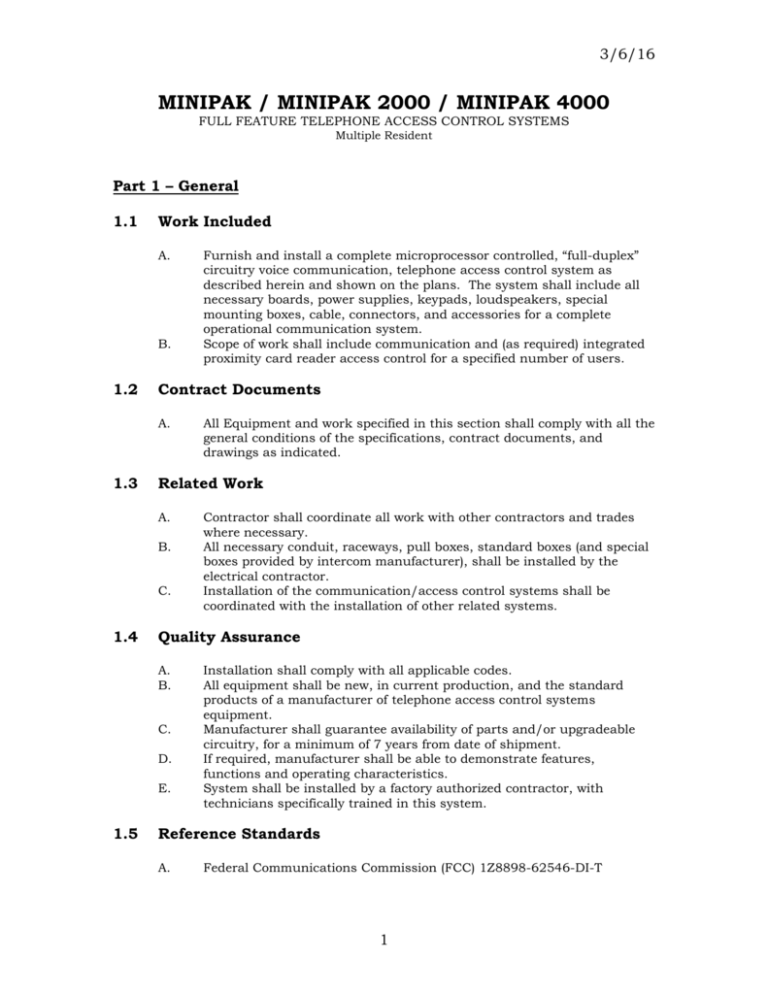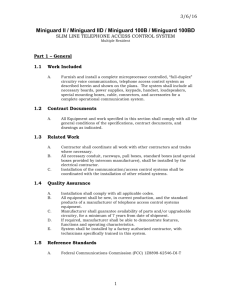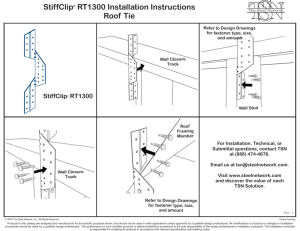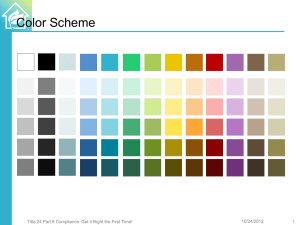Minipak Series - Trigon Electronics
advertisement

3/6/16 MINIPAK / MINIPAK 2000 / MINIPAK 4000 FULL FEATURE TELEPHONE ACCESS CONTROL SYSTEMS Multiple Resident Part 1 – General 1.1 Work Included A. B. 1.2 Contract Documents A. 1.3 B. C. Contractor shall coordinate all work with other contractors and trades where necessary. All necessary conduit, raceways, pull boxes, standard boxes (and special boxes provided by intercom manufacturer), shall be installed by the electrical contractor. Installation of the communication/access control systems shall be coordinated with the installation of other related systems. Quality Assurance A. B. C. D. E. 1.5 All Equipment and work specified in this section shall comply with all the general conditions of the specifications, contract documents, and drawings as indicated. Related Work A. 1.4 Furnish and install a complete microprocessor controlled, “full-duplex” circuitry voice communication, telephone access control system as described herein and shown on the plans. The system shall include all necessary boards, power supplies, keypads, loudspeakers, special mounting boxes, cable, connectors, and accessories for a complete operational communication system. Scope of work shall include communication and (as required) integrated proximity card reader access control for a specified number of users. Installation shall comply with all applicable codes. All equipment shall be new, in current production, and the standard products of a manufacturer of telephone access control systems equipment. Manufacturer shall guarantee availability of parts and/or upgradeable circuitry, for a minimum of 7 years from date of shipment. If required, manufacturer shall be able to demonstrate features, functions and operating characteristics. System shall be installed by a factory authorized contractor, with technicians specifically trained in this system. Reference Standards A. Federal Communications Commission (FCC) 1Z8898-62546-DI-T 1 3/6/16 1.6 Submittals A. B. C. 1.7 Provisions: Comply with Section 01300 SUBMITTALS Shall include an equipment list and data sheet, system description and block diagrams on equipment to be furnished. Shall include all data necessary to evaluate design, quality, and configuration of proposed equipment and system(s). Warranty A. B. C. Systems shall include a factory warranty that equipment is free from defects in design, material, manufacturing and operation. Factory warranty period shall be for two (2) years parts and workmanship; 24 months from date of shipment. Manufacturer shall not be responsible for improper use, handling, or installations of the product. Installing communications contractor shall guarantee the equipment, wire, cable, and installation for 12-months from date of acceptance. Part 2 – Products 2.1 Acceptable Manufacturers A. B. 2.2 The system as described herein is based on the 1. Minipak 2. Minipak 2000 3. Minipak 4000 telephone access control system manufactured by Trigon Electronics, Inc., Orange, California. The telephone access control system specified meets requirements of the specifications and shall be considered as the acceptable Base Bid. Substitutions must meet requirements of Prior Approval, as outlined in the contract documents. Substitutions that meet Prior Approval requirements must be listed as alternates by addendum, and shall be shown separately on the bid forms. Consideration will be based on ability to comply with all aspects of the specifications, the desired functional operation, quality, reliability, design, size and appearance of the equipment, and the support capabilities of the manufacturer. System Description A. B. C. The telephone access control system shall provide a “full-duplex” handsfree voice communication from the entry location to user telephones and shall provide access control for both guest and system users. Half duplex or simplex type communication will not be allowed. The system shall be a microprocessor based system and shall provide voice communication and access control through a touch-tone, loop-start dedicated control office telephone line. The system shall be capable of “full-duplex”, hands-free operation, without the use of handsets at the initiating / guest, door entry panel. The system shall be capable of accepting entry codes on the telephone key pad that will allow access to residents at the initiating / guest, door entry panel. 2 3/6/16 D. E. F. G. 2.3 System Configuration A. B. C. D. E. F. 2.4 The system requires a touch-tone, loop-start dedicated central office telephone line to provide voice communication and access control. A complete system shall consist of the telephone access control system and one or more pieces of the following equipment (see optional equipment); and connecting cables, wiring, mounting boxes and power supplies required for a complete installation. The systems programmable features shall be retained in EEPROM memory, which guarantees that programmed data is not lost during power outages or chip removal. The telephone access control system shall be surface, flush or pedestal mounted as shown on the plans. The system shall utilize an RJ11C or W phone jack. The system can be powered by either 12 volts AC or 12 volts DC. Normal operating power is through a plug-in 110V/12 VAC, 40 VA power transformer that is supplied with the unit. When an accessory such as a proximity card reader requires 12 volt DC, then a 12 volt DC power transformer is supplied and the overall system operates on 12 volt DC. System Features A. B. C. D. E. 2.5 The system shall be capable of autodialing a management telephone on detecting tamper criteria. Programming of the system shall be done directly on the keypad, remotely via touch-tone telephone, or optionally via RS232 direct connect with system management software, or remotely via PC programming with a computer modem interlink using system management software. The scope of the system shall include all necessary components for proper function and interface to existing telephone lines, and include all features and functions described herein and the equipment shown on the plans. System shall be capable of adding optional features, equipment and interfaces listed in the specifications even if not initially included or shown on the plans. A complete operational system shall be provided. The system shall be designed for various levels of resident unit capacity phone numbers up to 12 digits in length. The system shall be capable of independently controlling one main entry access point and alarm shunting during entry opening. A second dry contact 5 amp form C relay may be added to control internally mounted camera The system shall come equipped with a double baffled underwater rated fiber material hands free speaker. Microphone shall be housed at a right angle to the front in an acoustical chamber to enhance clarity while protecting the device from vandalism. The telephone access control system shall be capable of sending DTMF tones after a call from the entry systems if connected. The telephone access control system shall be capable of detecting touch tone and rotary tones to initiate access to guest. System Operation 3 3/6/16 A. B. C. 2.6 Guests shall locate a resident code on the adjacent paper directory or on the LCD readout, press the start button and enter the directory code on the system keypad to establish communication. Once communication is established, a resident may grant entry by pressing the programmed tone-open number, or may deny access by hanging up. If the call is unanswered, it will self-terminate after 3 minutes releasing the line or the start button can be depressed a second time to terminate. Residents may open the door or gate by using a unique four-digit entry code entered on the system keypad. Equipment A. All Models 1. The telephone units shall be no more than 12 ½ inches high, 9 ½ inches wide and 2.75 inches deep. 2. The complete unit shall be constructed from 16-guage, nonmagnetic, non-rusting, stainless steel, weather resistant, low profile enclosure in a wraparound style. Back plate has tamper resistant screws. 3. The speaker holes shall be offset to protect the speaker from vandalism. 4. The microphone shall be housed at a right angle to the front in an acoustical chamber to enhance clarity while protecting the device from vandalism 5. The unit shall use vandal resistant screws on all exterior areas. 6. The entry telephone shall utilize ADA compliant armored metal Braille enhanced keypad. 7. The control board shall be mounted to the front of the system enclosure for ease of service. 8. The units shall have a minimum of one five (5) amp form C relay and one 250ma alarm shunt relay. 9. The units shall be capable of ADA compliant hands-free operation. 10. The unit shall utilize a single start button to initiate dial tone. 11. The unit shall be capable of converting from a surface mount unit to a flush mount unit by exchanging the surface mount back box for the optional flush mount back box. 12. The unit shall come standard with an ADA compliant keypad, a standard postal lock compliant setup, a camera ready mounting system. 13. Telephone entry unit must be capable of generating an electronic site identification that reveals originating caller location. 14. The units must be capable of autodialing a preset number when tamper criteria are recognized. 15. Entry units must be capable of supporting all Weigand 26 bit protocol. B. Minipak 1. The unit shall have a 2.75 inch by 7 inch paper style, backlit directory. 2. The paper style directory must be accessible from the front of the telephone entry unit without opening the electronic section of the telephone. 4 3/6/16 3. 4. The entry telephone has resident capacities available in 24, 50, 125, 200, 300, or 400 units. Unit must be capable of controlling an optional secondary 5 amp form C relay for camera power control. C. Minipak 2000 1. The telephone access control system shall be capable of displaying resident names with associated resident directory codes, entry codes, telephone numbers and system operating parameters. 2. Unit shall have a built-in 2 line, backlit LCD scrolling directory (7 inches wide by 1 inch high). 3. Telephone unit must be capable of fast scrolling as well as jumping to letter groups through alphabetic key selection. 4. The entry telephone has resident capacities available in 24, 50, 125, 200, 300, or 400 units. 5. Programmable automatic unlock schedules via a built in seven day clock. The built-in time clock shall provide hold-open time zones and entry codes time zones. 6. An optional interface card provides complete integration of proximity card readers which can be mounted to the front of this unit. 7. Unit shall have a continually updating audit log recording all transactions performed by the telephone access control device. 8. Unit must be capable of controlling an optional secondary 5 amp form C relay for camera power control. D. Minipak 4000 1. The telephone access control system shall be capable of displaying resident names with associated resident directory codes, entry codes, telephone numbers and system operating parameters. 2. Unit shall have a built-in 15 line backlit LCD scrolling directory (3 inches wide x 5.25 inches high). 3. Telephone unit must be capable of fast scrolling as well as jumping to letter groups through alphabetic key selection. 4. Unit shall have a minimum of two 5 ampere form C relays and one 250ma alarm shunting relay. 5. System must have a user programmable welcome screen on the display. 6. The entry telephone has resident capacities available in 125, 250, 500, 750, 1000, 2000, 3000 or 4000 units. 7. Programmable automatic unlock schedules via a built in seven day clock. The built-in time clock shall provide hold-open time zones and entry codes time zones. 8. Internal telephone line modem for PC programming shall be standard. 9. Unit shall have a continually updating audit log recording all transactions performed by the telephone access control device. E. Optional Equipment 1. Second dry contact five (5) amp form C relay for camera control. 2. Internally mounted color or black/white camera. 3. Flush mount back box/trim ring. 4. Additional backlit paper style directory (12.5” x 9.5” x 2.75”). 5 3/6/16 5. 6. 7. 8. Internal telephone line modem for PC programming TrigonLink 2.5 remote PC programming software for Windows Decoder – desktop device decodes and displays Site ID information. Fiber Optic Compatible – International Fiber Systems model #’s – TT 2010, TR 2010, TT 2010WDM, TR 2010WDM, TT 2030, TR 2030, TT 2030WDM, TR 2030WDM. Part 3 – Execution 3.1 Installation A. B. C. D. E. F. G. H. 3.2 System Initializing and Programming A. B. C. D. 3.3 Unit shall be installed by qualified technicians who have been approved by the factory for such installations. Wiring shall be uniform and in accordance with national electric codes and manufacturers instructions. Installation shall conform to the manufacturers written requirements for installation. Systems are available for the following types of installation. 1. Surface mount (all units) 2. Flush mount (all units) Equipment shall be firmly secured, plumb and level. All splices shall be in easily accessible junction boxes or on terminal boards. All cable runs at the main control cabinets, in all auxiliary cabinets and at all phone blocks shall be tagged and identified. Coordinate all work with other effected trades and contractors. Fastenings: 1. Fasten on gypsum board wall surfaces with screws into wood or metal blocking, or with bolts or molly anchors, not less than ¼ inch diameter. Screwing into gypsum board or plaster with plugs will not be acceptable. 2. Fasten into concrete or masonry with self-drilling masonry anchors Phillips, Redhead, Bulldog or Rawl Sabertooth. System shall include all software and/or instruction necessary for system configuration. System shall be turned on and adjustment made to meet requirements of specifications and on-site conditions. System shall be programmed to function as specified. Directory numbers, feature codes and special programming shall be documented, printed and made available to all owners. System Test Procedures A. B. C. System shall be completely tested to assure that the exchange and all components, stations, speakers and accessories are hooked-up and functioning properly. System shall be pre-tested by contractor and certified to function in accordance with plans and specifications. System shall be tested in presence of owner’s representative. 6 3/6/16 3.4 Owner Instructions A. B. 3.5 Installation contractor shall conduct up to (2) hour of instructions in use and operation of the system to designated owner representatives, within (30) days of acceptance. Installation contractor shall conduct up to (2) hour for technical training, in programming, troubleshooting and service of the system, to designated owner representatives within (90) days of system acceptance. Manuals and Drawings A. B. Contractor shall provide owner with (2) copies of standard factory prepared operation, installation and maintenance manuals. Manuals shall include typical wiring diagrams. Contractor shall provide owner with (2) copies of any risers, layouts and special wiring diagrams showing any changes to standard drawings, if required on project. END OF SECTION 7








